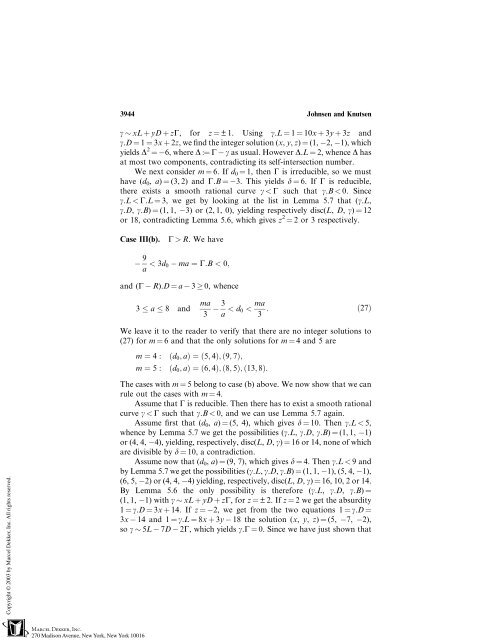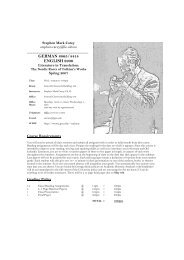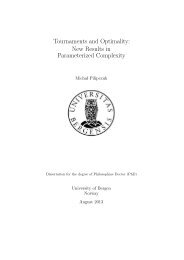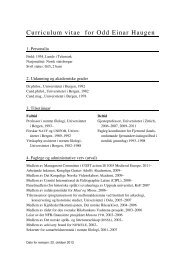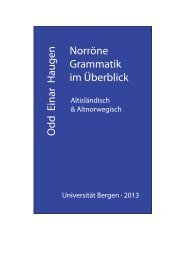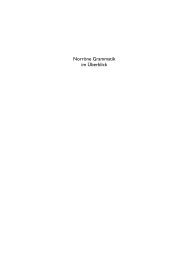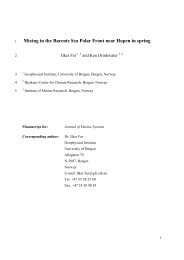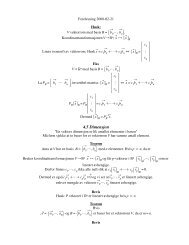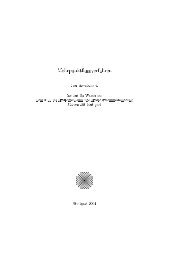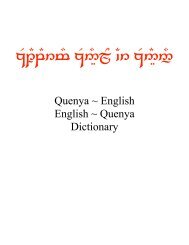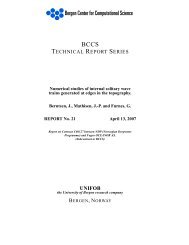Rational Curves in Calabi-Yau Threefolds
Rational Curves in Calabi-Yau Threefolds
Rational Curves in Calabi-Yau Threefolds
Create successful ePaper yourself
Turn your PDF publications into a flip-book with our unique Google optimized e-Paper software.
3944 Johnsen and Knutsen<br />
g xL þ yD þ zG, for z ¼ ± 1. Us<strong>in</strong>g g.L ¼ 1 ¼ 10x þ 3y þ 3z and<br />
g.D ¼ 1 ¼ 3x þ 2z, we f<strong>in</strong>d the <strong>in</strong>teger solution (x, y, z) ¼ (1, 2, 1), which<br />
yields D 2 ¼ 6, where D :¼ G g as usual. However D.L ¼ 2, whence D has<br />
at most two components, contradict<strong>in</strong>g its self-<strong>in</strong>tersection number.<br />
We next consider m ¼ 6. If d 0 ¼ 1, then G is irreducible, so we must<br />
have (d0, a) ¼ (3, 2) and G.B ¼ 3. This yields d ¼ 6. If G is reducible,<br />
there exists a smooth rational curve g < G such that g.B < 0. S<strong>in</strong>ce<br />
g.L < G.L ¼ 3, we get by look<strong>in</strong>g at the list <strong>in</strong> Lemma 5.7 that (g.L,<br />
g.D, g.B) ¼ (1, 1, 3) or (2, 1, 0), yield<strong>in</strong>g respectively disc(L, D, g) ¼ 12<br />
or 18, contradict<strong>in</strong>g Lemma 5.6, which gives z 2 ¼ 2 or 3 respectively.<br />
Case III(b). G > R. We have<br />
9<br />
a < 3d0 ma ¼ G:B < 0;<br />
and (G R).D ¼ a 3 0, whence<br />
3 a 8 and ma<br />
3<br />
3<br />
a < d0 < ma<br />
: ð27Þ<br />
3<br />
We leave it to the reader to verify that there are no <strong>in</strong>teger solutions to<br />
(27) for m ¼ 6 and that the only solutions for m ¼ 4 and 5 are<br />
m ¼ 4 : ðd0; aÞ ¼ð5; 4Þ; ð9; 7Þ;<br />
m ¼ 5 : ðd0; aÞ ¼ð6; 4Þ; ð8; 5Þ; ð13; 8Þ:<br />
The cases with m ¼ 5 belong to case (b) above. We now show that we can<br />
rule out the cases with m ¼ 4.<br />
Assume that G is reducible. Then there has to exist a smooth rational<br />
curve g < G such that g.B < 0, and we can use Lemma 5.7 aga<strong>in</strong>.<br />
Assume first that (d 0, a) ¼ (5, 4), which gives d ¼ 10. Then g.L < 5,<br />
whence by Lemma 5.7 we get the possibilities (g.L, g.D, g.B) ¼ (1, 1, 1)<br />
or (4, 4, 4), yield<strong>in</strong>g, respectively, disc(L, D, g) ¼ 16 or 14, none of which<br />
are divisible by d ¼ 10, a contradiction.<br />
Assume now that (d0, a) ¼ (9, 7), which gives d ¼ 4. Then g.L < 9 and<br />
by Lemma 5.7 we get the possibilities (g.L, g.D, g.B) ¼ (1, 1, 1), (5, 4, 1),<br />
(6, 5, 2) or (4, 4, 4) yield<strong>in</strong>g, respectively, disc(L, D, g) ¼ 16, 10, 2 or 14.<br />
By Lemma 5.6 the only possibility is therefore (g.L, g.D, g.B) ¼<br />
(1, 1, 1) with g xL þ yD þ zG, for z ¼ ±2.Ifz ¼ 2 we get the absurdity<br />
1 ¼ g.D ¼ 3x þ 14. If z ¼ 2, we get from the two equations 1 ¼ g.D ¼<br />
3x 14 and 1 ¼ g.L ¼ 8x þ 3y 18 the solution (x, y, z) ¼ (5, 7, 2),<br />
so g 5L 7D 2G, which yields g.G ¼ 0. S<strong>in</strong>ce we have just shown that


